Investment Opportunities in the Indian Market: A Detailed IKEA Report
VerifiedAdded on 2023/06/11
|6
|1518
|369
Report
AI Summary
This report analyzes investment opportunities in the Indian market, focusing on the potential for IKEA. It highlights the relationship between India and Sweden, including established economic ties and trade agreements. A SWOT analysis identifies strengths, weaknesses, opportunities, and threats within the Indian market. Key global dimensions for managers to focus on, such as real estate partnerships and social media marketing, are discussed. The report also examines India's economic growth, GDP, and social development index, emphasizing the country's young workforce and urbanization trends. Ultimately, it suggests that IKEA has significant profitable chances for growth in the Indian market due to its service-oriented approach and the country's favorable economic conditions.
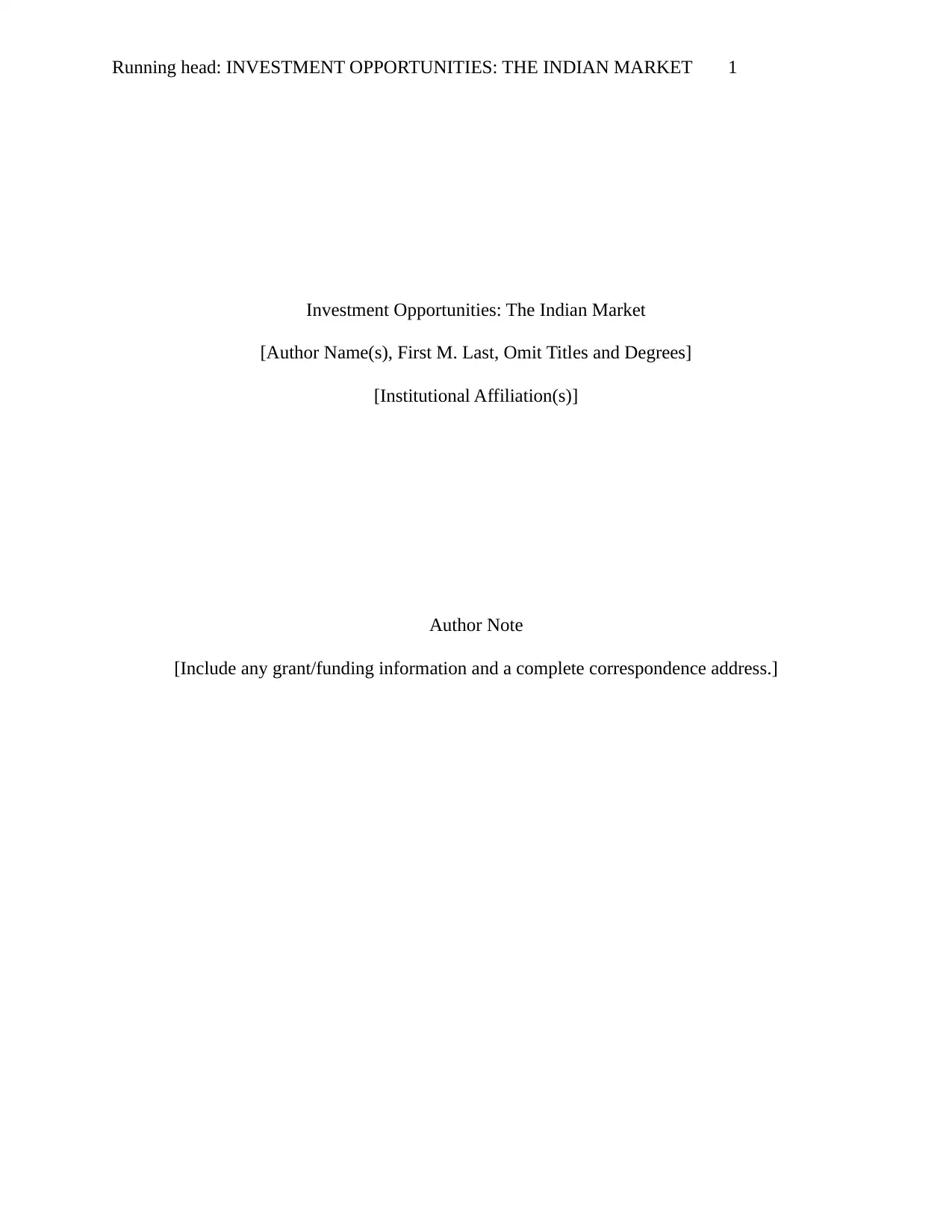
Running head: INVESTMENT OPPORTUNITIES: THE INDIAN MARKET 1
Investment Opportunities: The Indian Market
[Author Name(s), First M. Last, Omit Titles and Degrees]
[Institutional Affiliation(s)]
Author Note
[Include any grant/funding information and a complete correspondence address.]
Investment Opportunities: The Indian Market
[Author Name(s), First M. Last, Omit Titles and Degrees]
[Institutional Affiliation(s)]
Author Note
[Include any grant/funding information and a complete correspondence address.]
Paraphrase This Document
Need a fresh take? Get an instant paraphrase of this document with our AI Paraphraser
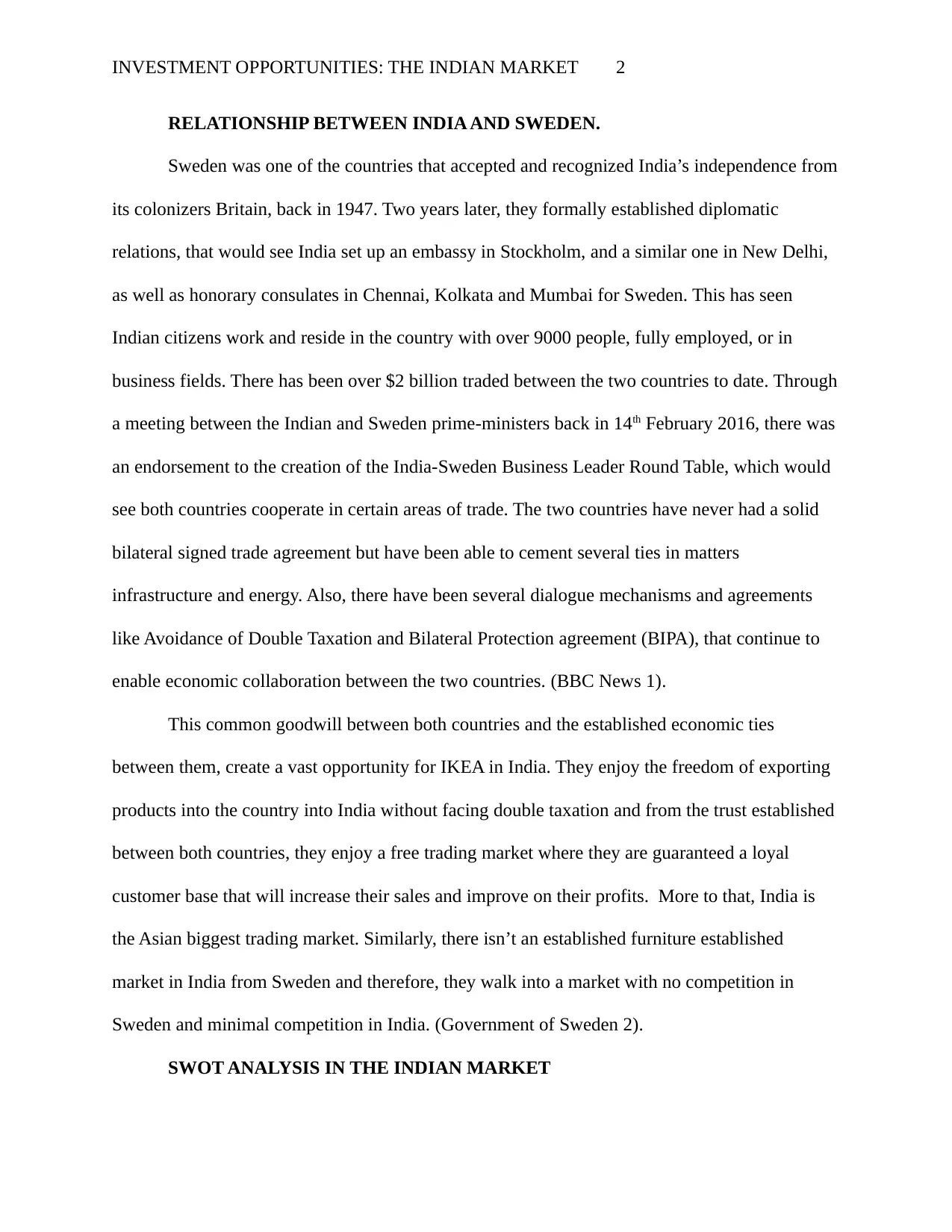
INVESTMENT OPPORTUNITIES: THE INDIAN MARKET 2
RELATIONSHIP BETWEEN INDIA AND SWEDEN.
Sweden was one of the countries that accepted and recognized India’s independence from
its colonizers Britain, back in 1947. Two years later, they formally established diplomatic
relations, that would see India set up an embassy in Stockholm, and a similar one in New Delhi,
as well as honorary consulates in Chennai, Kolkata and Mumbai for Sweden. This has seen
Indian citizens work and reside in the country with over 9000 people, fully employed, or in
business fields. There has been over $2 billion traded between the two countries to date. Through
a meeting between the Indian and Sweden prime-ministers back in 14th February 2016, there was
an endorsement to the creation of the India-Sweden Business Leader Round Table, which would
see both countries cooperate in certain areas of trade. The two countries have never had a solid
bilateral signed trade agreement but have been able to cement several ties in matters
infrastructure and energy. Also, there have been several dialogue mechanisms and agreements
like Avoidance of Double Taxation and Bilateral Protection agreement (BIPA), that continue to
enable economic collaboration between the two countries. (BBC News 1).
This common goodwill between both countries and the established economic ties
between them, create a vast opportunity for IKEA in India. They enjoy the freedom of exporting
products into the country into India without facing double taxation and from the trust established
between both countries, they enjoy a free trading market where they are guaranteed a loyal
customer base that will increase their sales and improve on their profits. More to that, India is
the Asian biggest trading market. Similarly, there isn’t an established furniture established
market in India from Sweden and therefore, they walk into a market with no competition in
Sweden and minimal competition in India. (Government of Sweden 2).
SWOT ANALYSIS IN THE INDIAN MARKET
RELATIONSHIP BETWEEN INDIA AND SWEDEN.
Sweden was one of the countries that accepted and recognized India’s independence from
its colonizers Britain, back in 1947. Two years later, they formally established diplomatic
relations, that would see India set up an embassy in Stockholm, and a similar one in New Delhi,
as well as honorary consulates in Chennai, Kolkata and Mumbai for Sweden. This has seen
Indian citizens work and reside in the country with over 9000 people, fully employed, or in
business fields. There has been over $2 billion traded between the two countries to date. Through
a meeting between the Indian and Sweden prime-ministers back in 14th February 2016, there was
an endorsement to the creation of the India-Sweden Business Leader Round Table, which would
see both countries cooperate in certain areas of trade. The two countries have never had a solid
bilateral signed trade agreement but have been able to cement several ties in matters
infrastructure and energy. Also, there have been several dialogue mechanisms and agreements
like Avoidance of Double Taxation and Bilateral Protection agreement (BIPA), that continue to
enable economic collaboration between the two countries. (BBC News 1).
This common goodwill between both countries and the established economic ties
between them, create a vast opportunity for IKEA in India. They enjoy the freedom of exporting
products into the country into India without facing double taxation and from the trust established
between both countries, they enjoy a free trading market where they are guaranteed a loyal
customer base that will increase their sales and improve on their profits. More to that, India is
the Asian biggest trading market. Similarly, there isn’t an established furniture established
market in India from Sweden and therefore, they walk into a market with no competition in
Sweden and minimal competition in India. (Government of Sweden 2).
SWOT ANALYSIS IN THE INDIAN MARKET
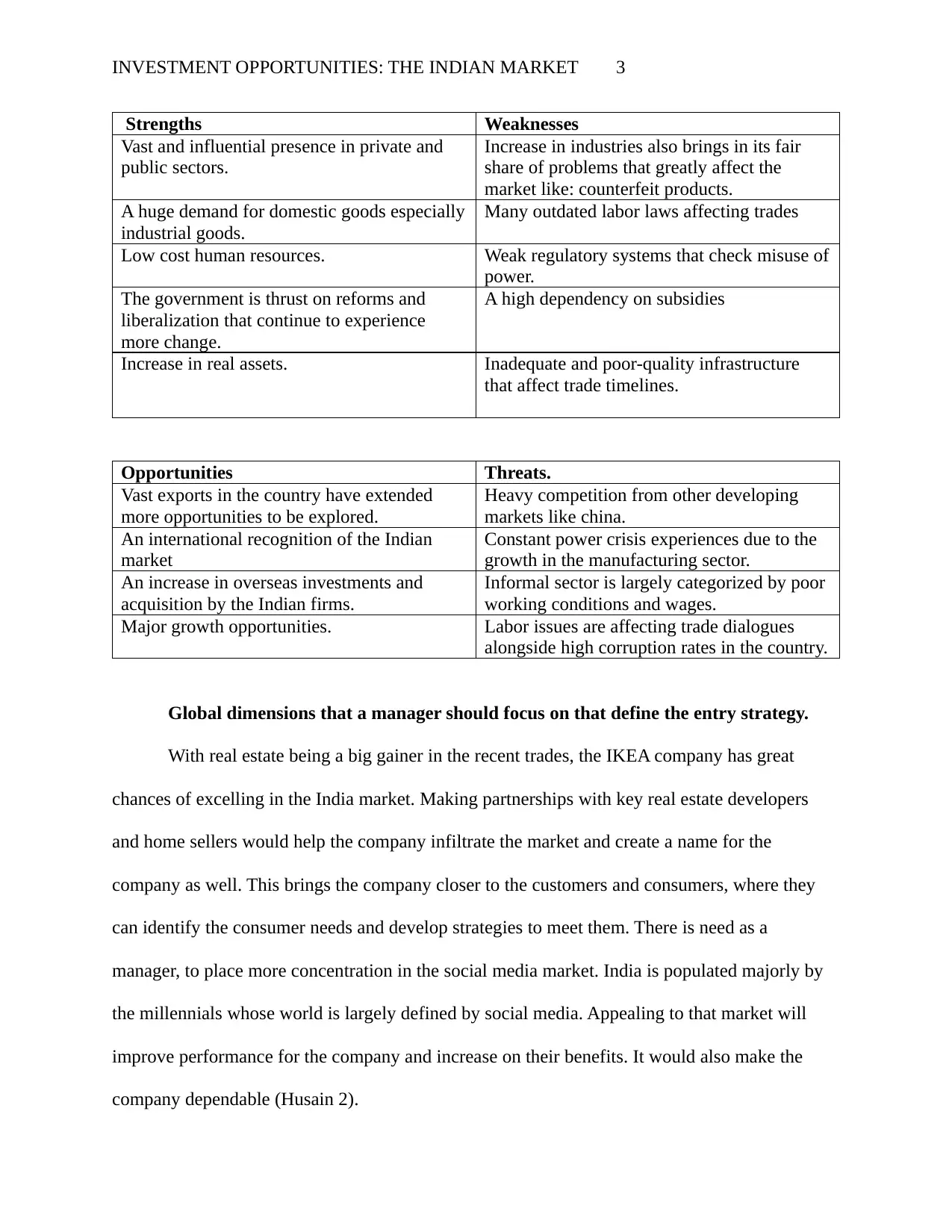
INVESTMENT OPPORTUNITIES: THE INDIAN MARKET 3
Strengths Weaknesses
Vast and influential presence in private and
public sectors.
Increase in industries also brings in its fair
share of problems that greatly affect the
market like: counterfeit products.
A huge demand for domestic goods especially
industrial goods.
Many outdated labor laws affecting trades
Low cost human resources. Weak regulatory systems that check misuse of
power.
The government is thrust on reforms and
liberalization that continue to experience
more change.
A high dependency on subsidies
Increase in real assets. Inadequate and poor-quality infrastructure
that affect trade timelines.
Opportunities Threats.
Vast exports in the country have extended
more opportunities to be explored.
Heavy competition from other developing
markets like china.
An international recognition of the Indian
market
Constant power crisis experiences due to the
growth in the manufacturing sector.
An increase in overseas investments and
acquisition by the Indian firms.
Informal sector is largely categorized by poor
working conditions and wages.
Major growth opportunities. Labor issues are affecting trade dialogues
alongside high corruption rates in the country.
Global dimensions that a manager should focus on that define the entry strategy.
With real estate being a big gainer in the recent trades, the IKEA company has great
chances of excelling in the India market. Making partnerships with key real estate developers
and home sellers would help the company infiltrate the market and create a name for the
company as well. This brings the company closer to the customers and consumers, where they
can identify the consumer needs and develop strategies to meet them. There is need as a
manager, to place more concentration in the social media market. India is populated majorly by
the millennials whose world is largely defined by social media. Appealing to that market will
improve performance for the company and increase on their benefits. It would also make the
company dependable (Husain 2).
Strengths Weaknesses
Vast and influential presence in private and
public sectors.
Increase in industries also brings in its fair
share of problems that greatly affect the
market like: counterfeit products.
A huge demand for domestic goods especially
industrial goods.
Many outdated labor laws affecting trades
Low cost human resources. Weak regulatory systems that check misuse of
power.
The government is thrust on reforms and
liberalization that continue to experience
more change.
A high dependency on subsidies
Increase in real assets. Inadequate and poor-quality infrastructure
that affect trade timelines.
Opportunities Threats.
Vast exports in the country have extended
more opportunities to be explored.
Heavy competition from other developing
markets like china.
An international recognition of the Indian
market
Constant power crisis experiences due to the
growth in the manufacturing sector.
An increase in overseas investments and
acquisition by the Indian firms.
Informal sector is largely categorized by poor
working conditions and wages.
Major growth opportunities. Labor issues are affecting trade dialogues
alongside high corruption rates in the country.
Global dimensions that a manager should focus on that define the entry strategy.
With real estate being a big gainer in the recent trades, the IKEA company has great
chances of excelling in the India market. Making partnerships with key real estate developers
and home sellers would help the company infiltrate the market and create a name for the
company as well. This brings the company closer to the customers and consumers, where they
can identify the consumer needs and develop strategies to meet them. There is need as a
manager, to place more concentration in the social media market. India is populated majorly by
the millennials whose world is largely defined by social media. Appealing to that market will
improve performance for the company and increase on their benefits. It would also make the
company dependable (Husain 2).
⊘ This is a preview!⊘
Do you want full access?
Subscribe today to unlock all pages.

Trusted by 1+ million students worldwide
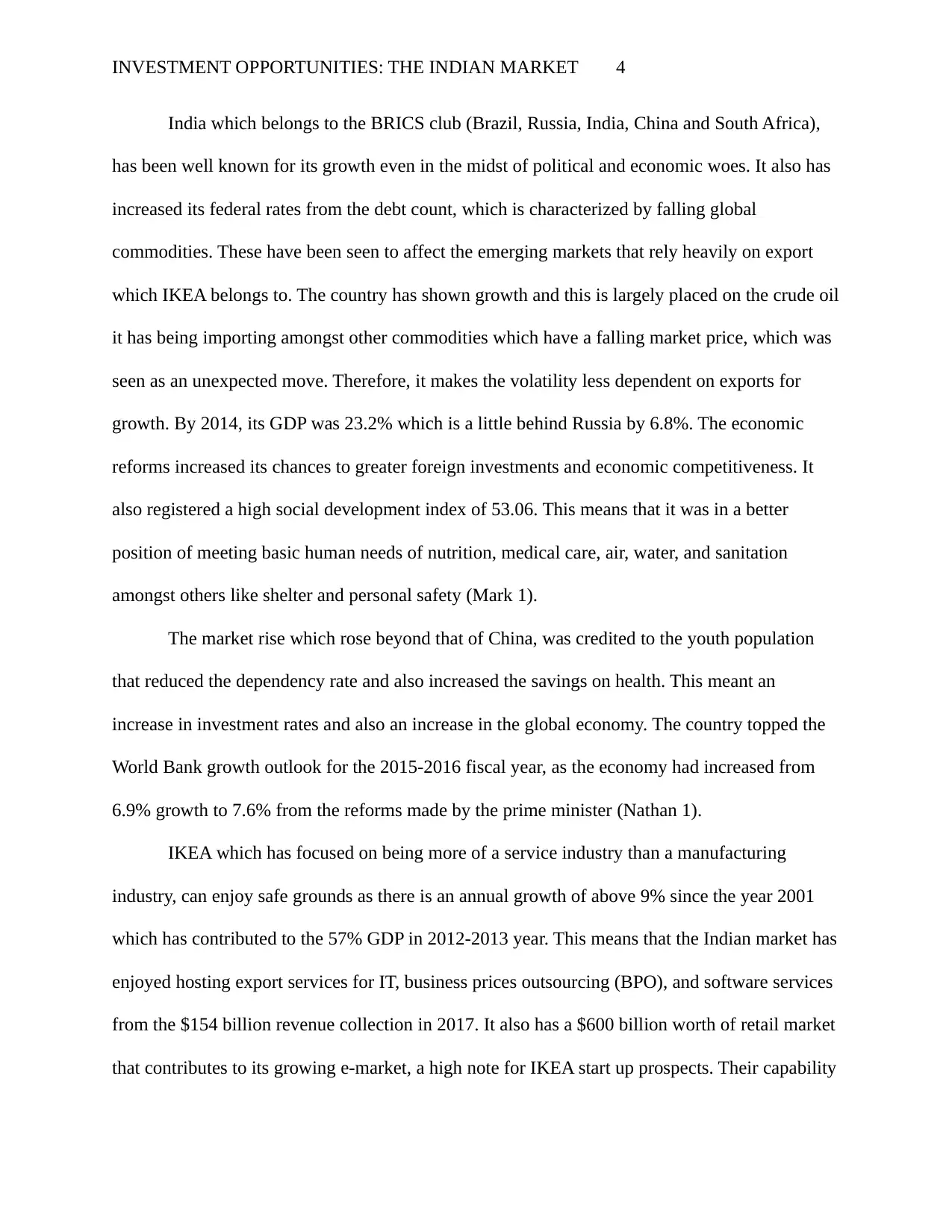
INVESTMENT OPPORTUNITIES: THE INDIAN MARKET 4
India which belongs to the BRICS club (Brazil, Russia, India, China and South Africa),
has been well known for its growth even in the midst of political and economic woes. It also has
increased its federal rates from the debt count, which is characterized by falling global
commodities. These have been seen to affect the emerging markets that rely heavily on export
which IKEA belongs to. The country has shown growth and this is largely placed on the crude oil
it has being importing amongst other commodities which have a falling market price, which was
seen as an unexpected move. Therefore, it makes the volatility less dependent on exports for
growth. By 2014, its GDP was 23.2% which is a little behind Russia by 6.8%. The economic
reforms increased its chances to greater foreign investments and economic competitiveness. It
also registered a high social development index of 53.06. This means that it was in a better
position of meeting basic human needs of nutrition, medical care, air, water, and sanitation
amongst others like shelter and personal safety (Mark 1).
The market rise which rose beyond that of China, was credited to the youth population
that reduced the dependency rate and also increased the savings on health. This meant an
increase in investment rates and also an increase in the global economy. The country topped the
World Bank growth outlook for the 2015-2016 fiscal year, as the economy had increased from
6.9% growth to 7.6% from the reforms made by the prime minister (Nathan 1).
IKEA which has focused on being more of a service industry than a manufacturing
industry, can enjoy safe grounds as there is an annual growth of above 9% since the year 2001
which has contributed to the 57% GDP in 2012-2013 year. This means that the Indian market has
enjoyed hosting export services for IT, business prices outsourcing (BPO), and software services
from the $154 billion revenue collection in 2017. It also has a $600 billion worth of retail market
that contributes to its growing e-market, a high note for IKEA start up prospects. Their capability
India which belongs to the BRICS club (Brazil, Russia, India, China and South Africa),
has been well known for its growth even in the midst of political and economic woes. It also has
increased its federal rates from the debt count, which is characterized by falling global
commodities. These have been seen to affect the emerging markets that rely heavily on export
which IKEA belongs to. The country has shown growth and this is largely placed on the crude oil
it has being importing amongst other commodities which have a falling market price, which was
seen as an unexpected move. Therefore, it makes the volatility less dependent on exports for
growth. By 2014, its GDP was 23.2% which is a little behind Russia by 6.8%. The economic
reforms increased its chances to greater foreign investments and economic competitiveness. It
also registered a high social development index of 53.06. This means that it was in a better
position of meeting basic human needs of nutrition, medical care, air, water, and sanitation
amongst others like shelter and personal safety (Mark 1).
The market rise which rose beyond that of China, was credited to the youth population
that reduced the dependency rate and also increased the savings on health. This meant an
increase in investment rates and also an increase in the global economy. The country topped the
World Bank growth outlook for the 2015-2016 fiscal year, as the economy had increased from
6.9% growth to 7.6% from the reforms made by the prime minister (Nathan 1).
IKEA which has focused on being more of a service industry than a manufacturing
industry, can enjoy safe grounds as there is an annual growth of above 9% since the year 2001
which has contributed to the 57% GDP in 2012-2013 year. This means that the Indian market has
enjoyed hosting export services for IT, business prices outsourcing (BPO), and software services
from the $154 billion revenue collection in 2017. It also has a $600 billion worth of retail market
that contributes to its growing e-market, a high note for IKEA start up prospects. Their capability
Paraphrase This Document
Need a fresh take? Get an instant paraphrase of this document with our AI Paraphraser
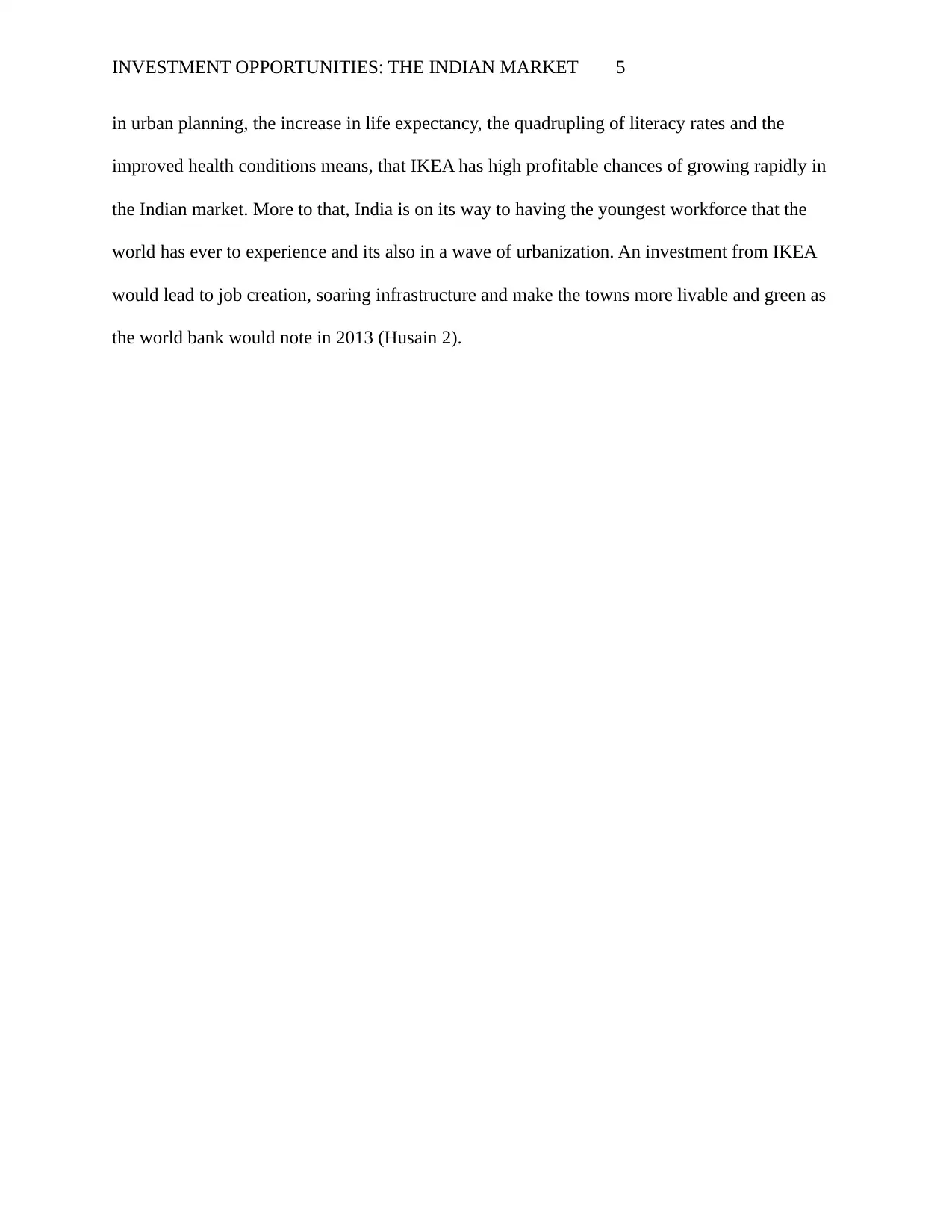
INVESTMENT OPPORTUNITIES: THE INDIAN MARKET 5
in urban planning, the increase in life expectancy, the quadrupling of literacy rates and the
improved health conditions means, that IKEA has high profitable chances of growing rapidly in
the Indian market. More to that, India is on its way to having the youngest workforce that the
world has ever to experience and its also in a wave of urbanization. An investment from IKEA
would lead to job creation, soaring infrastructure and make the towns more livable and green as
the world bank would note in 2013 (Husain 2).
in urban planning, the increase in life expectancy, the quadrupling of literacy rates and the
improved health conditions means, that IKEA has high profitable chances of growing rapidly in
the Indian market. More to that, India is on its way to having the youngest workforce that the
world has ever to experience and its also in a wave of urbanization. An investment from IKEA
would lead to job creation, soaring infrastructure and make the towns more livable and green as
the world bank would note in 2013 (Husain 2).
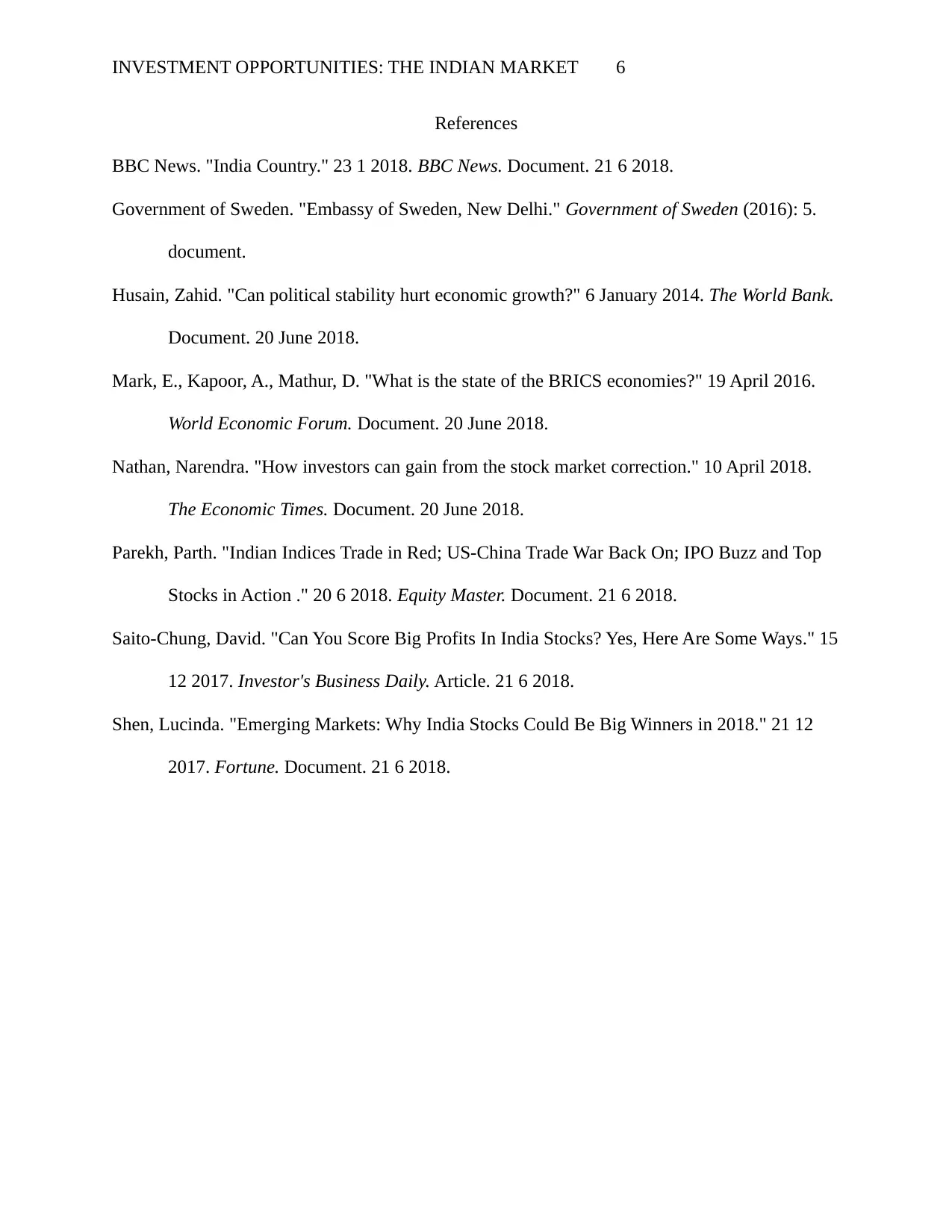
INVESTMENT OPPORTUNITIES: THE INDIAN MARKET 6
References
BBC News. "India Country." 23 1 2018. BBC News. Document. 21 6 2018.
Government of Sweden. "Embassy of Sweden, New Delhi." Government of Sweden (2016): 5.
document.
Husain, Zahid. "Can political stability hurt economic growth?" 6 January 2014. The World Bank.
Document. 20 June 2018.
Mark, E., Kapoor, A., Mathur, D. "What is the state of the BRICS economies?" 19 April 2016.
World Economic Forum. Document. 20 June 2018.
Nathan, Narendra. "How investors can gain from the stock market correction." 10 April 2018.
The Economic Times. Document. 20 June 2018.
Parekh, Parth. "Indian Indices Trade in Red; US-China Trade War Back On; IPO Buzz and Top
Stocks in Action ." 20 6 2018. Equity Master. Document. 21 6 2018.
Saito-Chung, David. "Can You Score Big Profits In India Stocks? Yes, Here Are Some Ways." 15
12 2017. Investor's Business Daily. Article. 21 6 2018.
Shen, Lucinda. "Emerging Markets: Why India Stocks Could Be Big Winners in 2018." 21 12
2017. Fortune. Document. 21 6 2018.
References
BBC News. "India Country." 23 1 2018. BBC News. Document. 21 6 2018.
Government of Sweden. "Embassy of Sweden, New Delhi." Government of Sweden (2016): 5.
document.
Husain, Zahid. "Can political stability hurt economic growth?" 6 January 2014. The World Bank.
Document. 20 June 2018.
Mark, E., Kapoor, A., Mathur, D. "What is the state of the BRICS economies?" 19 April 2016.
World Economic Forum. Document. 20 June 2018.
Nathan, Narendra. "How investors can gain from the stock market correction." 10 April 2018.
The Economic Times. Document. 20 June 2018.
Parekh, Parth. "Indian Indices Trade in Red; US-China Trade War Back On; IPO Buzz and Top
Stocks in Action ." 20 6 2018. Equity Master. Document. 21 6 2018.
Saito-Chung, David. "Can You Score Big Profits In India Stocks? Yes, Here Are Some Ways." 15
12 2017. Investor's Business Daily. Article. 21 6 2018.
Shen, Lucinda. "Emerging Markets: Why India Stocks Could Be Big Winners in 2018." 21 12
2017. Fortune. Document. 21 6 2018.
⊘ This is a preview!⊘
Do you want full access?
Subscribe today to unlock all pages.

Trusted by 1+ million students worldwide
1 out of 6
Related Documents
Your All-in-One AI-Powered Toolkit for Academic Success.
+13062052269
info@desklib.com
Available 24*7 on WhatsApp / Email
![[object Object]](/_next/static/media/star-bottom.7253800d.svg)
Unlock your academic potential
Copyright © 2020–2025 A2Z Services. All Rights Reserved. Developed and managed by ZUCOL.





